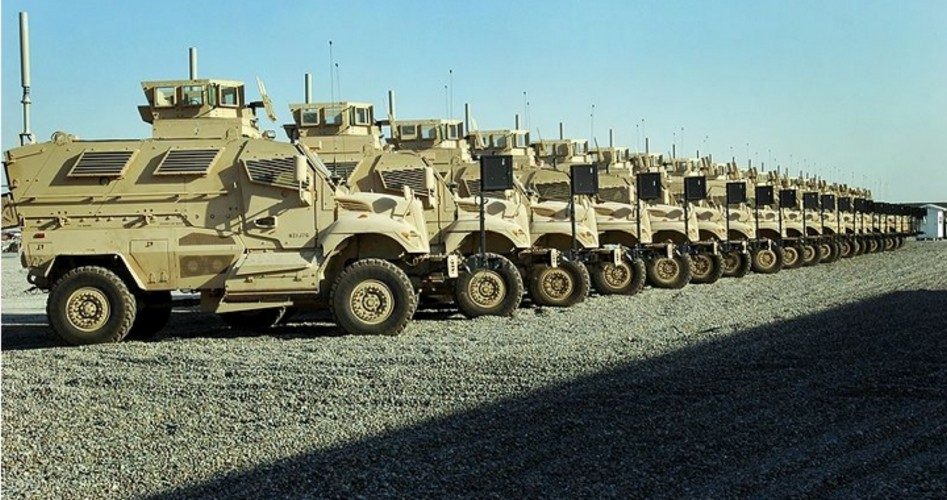
Last week New Jersey Governor Chris Christie signed into a law a bill (passed unanimously by both houses) that made his state the first to require local approval before any local law-enforcement agency can accept military equipment from the U.S. government. It won’t be the last.
Even stronger bills banning the practice, under the so-called “1033 Program” of local law-enforcement agencies dealing directly with the Department of Defense for free military equipment, are pending in Montana, Massachusetts, and Minnesota.
It was touch and go in New Hampshire: A similar bill failed, even following a decision by the police department in Concord to accept a BearCat (an armored personnel carrier) despite huge public protests with citizens carrying signs saying “More Mayberry, Less Fallujah” and “Thanks But No Tanks!” and a petition drive that netted 1,500 signatures from a town of just over 40,000.
There is increasing pushback against the militarization of police elsewhere. After the Salinas, California, police department was given a similar vehicle for free, it received torrents of protests, with one citizen familiar with the potential for the increasing threat to freedom from the nationalization of local police writing on the town’s Facebook page: “When did Salinas turn into a battlefield? I feel the Constitution shredding under my feet!”
In upstate New York’s Jefferson County, the federal gift of an MRAP (a 14-foot high, 44,000-pound Mine-Resistant Ambush Protected vehicle designed specifically to withstand IEDs [Improvised Explosive Devices]) led to similar angry protests.
Since 1997, the year the 1033 program began, some 8,000 local law-enforcement agencies have accepted over $5 billion worth of military hardware, with predictable results. According to a study by the ACLU published late last year entitled “War Comes Home,” that equipment is turning local officers into military forces, arming them “with the weapons and tactics of war,” with essentially no public discussion, permission, or oversight. As the ACLU noted, “The use of hyper aggressive tools and tactics results in tragedy for civilians and police officers, escalates the risk of needless violence, destroys property and undermines individual liberties.”
Perhaps the key event in the history of the militarization of the police began following the 1997 North Hollywood shootout where two bank robbers, dressed in body armor and carrying modified fully-automatic weapons, terrorized bank employees and customers for 44 minutes while successfully neutralizing attempts by local officers to end the rampage. Following the shootout, the Department of Defense gave the LAPD 600 surplus M-16 rifles, opening the way, thanks to the 1033 program initiated that same year, to the present flood of military equipment being transferred from battlefields in Iraq and Afghanistan to peaceful and law-abiding towns and cities in the United States.
It’s obvious what’s happening. As Glen Greenwald, who helped Edward Snowden with his NSA revelations, noted after observing the excessive use of force during the Occupy Wall Street demonstrations in 2011: “The police response was so excessive, and so clearly modeled after battlefield tactics, that there was no doubt that deterring domestic dissent is one of the primary aims of police militarization.”
In simple terms, the American citizen is now viewed increasingly as a battlefield opponent, thanks to that militarization. In the early 1970s, there were about 300 SWAT (Special Weapons and Tactics) team raids a year. Today they are estimated to exceed 50,000. Some police departments are using heavy-handed tactics such as delivering and enforcing search warrants with dozens of heavily armed and clothed police carried in MRAP vehicles. In Fairfax, Virginia, that’s all they use. Says the ACLU:
Heavily-armed SWAT teams are raiding people’s homes in the middle of the night, often just to search for drugs … [causing people needlessly to] die during these raids … [and turning neighborhoods] into war zones.
Such militarization is changing how police are viewed by the communities, said Senator Claire McCaskill (D-Mo.): “Giving military-grade weapons to every police force and every officer comes with costs. Officers dressed in military [gear] will not be viewed as partners in any community.”
One of the most effective tools concerned citizens are using to inform others is Radley Balko’s book The Rise of the Warrior Cop, published last summer. He traces the militarization of local police from the unrest of the 1960s which brought about the SWAT team, to Nixon’s War on Drugs, Reagan’s War on Poverty, Clinton’s federal COPS (Community Oriented Policing Services) begun in 1994, to, finally, the post-9/11 “security state” under the Bush and Obama administrations.
Little known is the fact that Balko had long been writing while being funded by the Koch Brothers, who have financed numerous educational efforts dedicated to informing the public about the dangers of a national police force. Also not well enough known are the efforts of members of the Support Your Local Police (SYLP) committees begun by The John Birch Society in the 1960s, recognizing very early the threats to freedom from a nationalized law-enforcement power. Said a spokesman for SYLP, “We were successful in stopping Police Civilian Review Boards in the 1960s and ’70s and in getting the federal government’s Law Enforcement Assistance Administration (LEAA) abolished in 1982.”
The decision by Governor Christie to sign the new law is simply the natural political result of decades-long efforts to educate a citizenry about those threats. As those threats are now appearing on more and more city streets, the education process moves to political action, as it always has.
A graduate of an Ivy League school and a former investment advisor, Bob is a regular contributor to The New American magazine and blogs frequently at www.LightFromTheRight.com, primarily on economics and politics.



